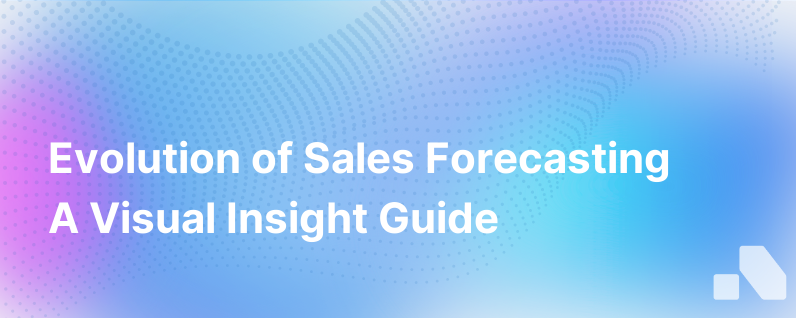Evolution Of The Sales Forecast Infographic
Published on October 23, 2023 by David Zhang
Sales forecasting has been a critical element of business strategy and management for ages, and its methods have evolved significantly over the years. The visuals we use to interpret and communicate sales predictions—forecasts—have morphed alongside advancements in technology, data collection, and analysis methodologies. Today, infographics are a popular format for conveying complex sales forecasts in an accessible and visually engaging manner.
Let's embark on a journey through the evolution of the sales forecast infographic, exploring its origins, advancements over time, and the state-of-the-art techniques that inform today’s best practices.
The Origins: Intuition and Experience-Based Forecasting
In the early days of sales, forecasting was as much an art as a science. Business owners and sales managers relied heavily on intuition and past experiences to predict future sales. These predictions, while rooted in some form of reality, were largely speculative and often represented in simple charts and tables, if at all.
Infographic Style: Minimalist line graphs and ledger-like tables in monochrome or two-tone color schemes were the norm in these early days. Visual aids were typically hand-drawn and captured basic trends over time.
The Advent of Statistical Methods
Fast forward to the 20th century, and statistical methods began to elevate sales forecasting from an art to a more rigorous science. Regression analysis and time-series forecasting started to take center stage. These methods allowed sales teams to identify and leverage historical patterns to better predict future outcomes.
Infographic Style: Statistical charts gained popularity. Multi-colored line and bar graphs appeared, reflecting the increased complexity and data points in sales forecasting. However, these were still largely static visuals prepared by analysts using nascent computer technology.
The Computer Age: Data-Driven Infographics
The introduction of computers brought about a seismic shift in sales forecasting. Spreadsheet software like Microsoft Excel revolutionized the way data was collected and analyzed, making forecasts more reliable and the process significantly faster.
Infographic Style: The use of richer visuals exploded. Charts and graphs became more sophisticated, featuring a range of colors and graphical elements. The data behind these visuals was easily manipulated through spreadsheet software, and sales teams began to see more elaborate and dynamic infographics that could be updated with ease.
The Rise of Predictive Analytics
As computational power increased, so did the complexity of forecasting methods. Predictive analytics and big data moved to the forefront, harnessing the power of machine learning algorithms to parse through vast quantities of data. Patterns previously unseen by human analysts now informed predictions about future sales performance.
Infographic Style: Dashboards and interactive infographics started to trend. Visual forecasting tools became more dynamic and could respond to real-time data inputs. Predictive models often had their own visualization formats, capable of representing multi-dimensional data and insights.
The Present: AI-Driven Interactive Infographics
Now, in the 21st century, we stand on the cusp of an era powered by Artificial Intelligence (AI) and machine learning. Current sales forecasting tools can include everything from market trends to socio-economic factors, and even sentiments extracted from social media analysis.
Infographic Style: State-of-the-art sales forecast infographics are now fully interactive, often part of sophisticated Business Intelligence (BI) platforms. They use animations, adjustable data ranges, and can even incorporate AI-driven 'what-if' scenarios to help stakeholders visualize potential outcomes under different conditions.
The Future: Predictive & Prescriptive Analytics Combined
Looking ahead, sales forecast infographics will continue to adapt and become more insightful. The next leap forward may involve not only predicting outcomes but also prescribing actions. Prescriptive analytics will take into account a wider array of variables, including real-time market conditions and behavioral data, to recommend specific strategies to maximize sales outcomes.
Infographic Style: The future of sales forecasting infographics lies in immersive experiences. Virtual Reality (VR) or Augmented Reality (AR) incorporation could allow stakeholders to step into a virtual representation of their market and interact with data in three dimensions. Infographics will no longer just convey information but will enable users to experience and manipulate forecast data in a virtual space.
Conclusion: A Visual Revolution
The sales forecast infographic has come a long way from its humble beginnings. With each leap in technology, its ability to capture and communicate complex data has grown. What was once a straightforward bar chart has morphed into a highly engaging, interactive dashboard that puts comprehensive predictive power at our fingertips.
Through visualization innovation, forecasting has moved from speculative art to dynamic science—empowering sales teams to operate with unprecedented foresight. As computational technology races forward, so too will the creativity and functionality of the sales forecast infographic, with prescriptive analytics paving the way for even more actionable business intelligence.
In the hands of a skilled sales strategist, the modern sales infographic is an indispensable tool; one that is not only informative but also a catalyst for informed decision-making, offering a glimpse into the future of sales potential. As we embrace these advances, we also eagerly anticipate the next chapter in the evolution of sales forecasting infographics.